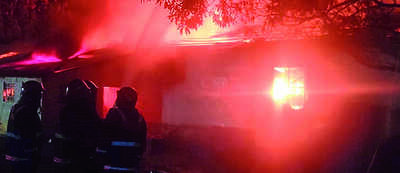- News
- City News
- thiruvananthapuram News
- Bleaching powder storage method a cause for concern
Trending Topics
Bleaching powder storage method a cause for concern

Thiruvananthapuram: While forensic probe results are being awaited on what exactly caused the fire in KMSCL warehouse at Thumba, the storage of bleaching powder has become a challenge for the health department. An official with the health department has termed bleaching powder as a double edged sword in the wake of recent fire events. He may be right, it seems.
The thermal decomposition properties of bleaching powder (calcium hypochlorite) warranted attention when there had been fires in cargo ships towards the end of 1990s which were attributed to the carriage of calcium hypochlorite. Research showed that the hydrated form of high strength calcium hypochlorite is capable of self-heating at relatively low temperatures.
Fires started by decomposition of calcium hypochlorite typically occur very fast and the first sign is often an explosion. Decomposition of the product liberates hazardous chlorine gas and also oxygen, which intensifies the resulting fire.
The material safety data sheets (MSDS) of bleaching powder categorises it as non-flammable, however under the oxidizing and explosive properties, the MSDS also notes ‘strong oxidizer, so it has serious fire and explosion risks’. It further adds ‘contact with combustible materials may cause fire’.
It is at this point things get cloudy when it comes to the Thumba incident. According to KMSCL authorities, only bleaching powder was stored in the room; around 29,000 kg in a room measuring less than 2,000 sqft. All the other chemicals were stored in other rooms which were not affected by the fire.
Officials and technical experts with the fire safety department say that warehouses that supply materials to hospitals also store materials like surgical spirit, sanitizers, cleaning solutions and glycerine. Bleaching powder could cause fire when it comes into contact with incompatible substances like acid or alcohol. The fire safety officials said that it needs to be found out whether combustible materials were kept close to bleaching powder packs.
The document further notes that if heat is generated inside a package faster than it can be lost, the temperature of the calcium hypochlorite will escalate leading to the possibility of explosion. If the product undergoes thermal runaway while packed in or stowed next to combustible materials, an explosion is likely to be followed by a fire. It would require a detailed scientific probe to find out whether such self-reactive behaviour owing to non-compliance with conditions like ambient temperature or ventilation led to fire and cost a human life at Thumba.
So far, the drugs control department has been handed over samples from other warehouses. However, the task is far from identifying the exact cause of the fire. The drugs control department will do primarily a quality check focusing on chlorine content.
The thermal decomposition properties of bleaching powder (calcium hypochlorite) warranted attention when there had been fires in cargo ships towards the end of 1990s which were attributed to the carriage of calcium hypochlorite. Research showed that the hydrated form of high strength calcium hypochlorite is capable of self-heating at relatively low temperatures.
Fires started by decomposition of calcium hypochlorite typically occur very fast and the first sign is often an explosion. Decomposition of the product liberates hazardous chlorine gas and also oxygen, which intensifies the resulting fire.
The material safety data sheets (MSDS) of bleaching powder categorises it as non-flammable, however under the oxidizing and explosive properties, the MSDS also notes ‘strong oxidizer, so it has serious fire and explosion risks’. It further adds ‘contact with combustible materials may cause fire’.
It is at this point things get cloudy when it comes to the Thumba incident. According to KMSCL authorities, only bleaching powder was stored in the room; around 29,000 kg in a room measuring less than 2,000 sqft. All the other chemicals were stored in other rooms which were not affected by the fire.
Officials and technical experts with the fire safety department say that warehouses that supply materials to hospitals also store materials like surgical spirit, sanitizers, cleaning solutions and glycerine. Bleaching powder could cause fire when it comes into contact with incompatible substances like acid or alcohol. The fire safety officials said that it needs to be found out whether combustible materials were kept close to bleaching powder packs.
The document further notes that if heat is generated inside a package faster than it can be lost, the temperature of the calcium hypochlorite will escalate leading to the possibility of explosion. If the product undergoes thermal runaway while packed in or stowed next to combustible materials, an explosion is likely to be followed by a fire. It would require a detailed scientific probe to find out whether such self-reactive behaviour owing to non-compliance with conditions like ambient temperature or ventilation led to fire and cost a human life at Thumba.
So far, the drugs control department has been handed over samples from other warehouses. However, the task is far from identifying the exact cause of the fire. The drugs control department will do primarily a quality check focusing on chlorine content.
Start a Conversation
FOLLOW US ON SOCIAL MEDIA
FacebookTwitterInstagramKOO APPYOUTUBE







